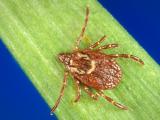Feb 24, 2005 (CIDRAP News) – Knowledge of the local epidemiology of tularemia can help healthcare providers identify the disease and recommend locally appropriate prevention and control steps, according to a report from the Centers for Disease Control and Prevention (CDC).
The report focuses on an uncommon route of tularemia transmission that was repeatedly found in recent cases in Wyoming: insect bites. Deerflies, horseflies, or other insects are considered the culprits behind 7 of 11 human tularemia cases that occurred there from 2001 through 2003, the CDC says in the Feb 25 issue of Morbidity and Mortality Weekly Report.
Tick bites and handling of infected animals are the most common route of infection with tularemia, one of the six diseases considered most likely to be spread by terrorists. People can also contract it from insect bites, eating or drinking contaminated food or water, or inhaling the bacteria, according to the CDC.
The illness, which is caused by the bacterium Francisella tularensis, occurs in six syndromes, of which ulceroglandular is the most common. The disease can be fatal if left untreated, but the overall case-fatality rate in the United States is less than 2%, according to a review published in 2001.
The recent cases in Wyoming might have stood out initially because of their numbers. Six confirmed and five probable human tularemia cases occurred from 2001 through 2003 in western and southwestern Wyoming, versus only 10 cases from 1990 through 2000, the report says.
The outbreak, however, became noteworthy for another reason when investigators from the state health department learned that insects (deerflies, horseflies, flies and/or fleas) were the most likely mode of transmission in 7 of the 11 cases. In contrast, none of the cases in the preceding decade had been linked to insect bites. Six of the seven patients suffered ulceroglandular tularemia, and one had typhoidal tularemia, the report says.
Most of the recent human cases were in southwestern Wyoming, and there were signs of a tularemia outbreak among rabbits in that part of the state during the same years, the article says. The state health department learned in October 2003 that two ill rabbits from the Seedskadee National Wildlife Refuge had tested positive for the disease. Refuge staff also noted higher numbers of sick or dead rabbits during 2002 and 2003.
There was evidence of a possible link between the apparent rabbit outbreak and the human cases, according to the report. F tularensis isolates from the six confirmed human cases were classified into types A or B. Five of the six isolates were from southwestern Wyoming, where the rabbit outbreak was believed to have occurred, and all five were type A, the type usually associated with rabbits.
In addition, the CDC reports that laboratory studies as far back as 1919 confirmed that deerflies can spread tularemia among animals.
The lesson is that local conditions matter. "Because proper diagnosis and treatment of tularemia relies on a high index of suspicion and clinical presentation is related to the method of acquisition . . . healthcare providers should understand the local epidemiology of tularemia," the report says. "On the basis of this knowledge, public health officials can recommend locally appropriate prevention and control measures."
"In addition, a local epizootic of tularemia might correlate with an increase in human cases and should heighten awareness that tularemia might be a possibility in clinically compatible cases," the article says.
The findings were limited by patients' possible recall bias, as well as the potential for unrecognized modes of transmission, the article says.
CDC. Tularemia transmitted by insect bites—Wyoming, 2001-2003. MMWR 2005 Feb 25:54(7):170-3 [Full text]
See also:















